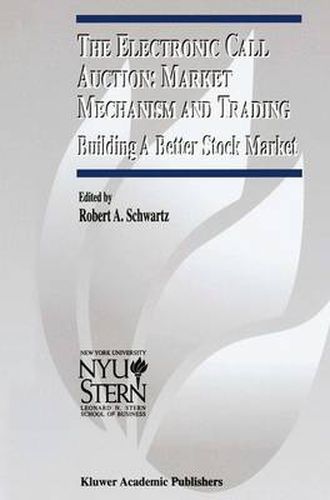Readings Newsletter
Become a Readings Member to make your shopping experience even easier.
Sign in or sign up for free!
You’re not far away from qualifying for FREE standard shipping within Australia
You’ve qualified for FREE standard shipping within Australia
The cart is loading…






This title is printed to order. This book may have been self-published. If so, we cannot guarantee the quality of the content. In the main most books will have gone through the editing process however some may not. We therefore suggest that you be aware of this before ordering this book. If in doubt check either the author or publisher’s details as we are unable to accept any returns unless they are faulty. Please contact us if you have any questions.
This title considers how the inclusion of electronic call auction trading would affect the performance of our US equity markets. The papers it contains focus on the call auction and its role in a hybrid market structure. The purpose is to increase understanding of this trading environment, and to consider the design of a more efficient stock market. Call auction is a form of trading that died out in the pre-computer age but is making its re-entrance as an electronic marketplace. Batching orders for simultaneous execution at a single moment in time at a single price is the essence of call auction trading. Because its determination is based on the full set of orders, the clearing price in a call auction can be thought of as a consensus value . This contrasts with a continuous market where a transaction is made any time a buy and sell order meet in price, and where price generally fluctuates as the orders meet. Recent advances in computer technology have considerably expanded the call auction’s functionality. The book is divided into three parts; the first, Call Auction Trading , gives an overview of this trading environment; the second, Investor Trading Practices and the Demand for Immediacy , contains the findings of four institutional trader surveys; the third, Market Structure: The Broader Picture , presents a more inclusive view of the development of market structure.
$9.00 standard shipping within Australia
FREE standard shipping within Australia for orders over $100.00
Express & International shipping calculated at checkout
This title is printed to order. This book may have been self-published. If so, we cannot guarantee the quality of the content. In the main most books will have gone through the editing process however some may not. We therefore suggest that you be aware of this before ordering this book. If in doubt check either the author or publisher’s details as we are unable to accept any returns unless they are faulty. Please contact us if you have any questions.
This title considers how the inclusion of electronic call auction trading would affect the performance of our US equity markets. The papers it contains focus on the call auction and its role in a hybrid market structure. The purpose is to increase understanding of this trading environment, and to consider the design of a more efficient stock market. Call auction is a form of trading that died out in the pre-computer age but is making its re-entrance as an electronic marketplace. Batching orders for simultaneous execution at a single moment in time at a single price is the essence of call auction trading. Because its determination is based on the full set of orders, the clearing price in a call auction can be thought of as a consensus value . This contrasts with a continuous market where a transaction is made any time a buy and sell order meet in price, and where price generally fluctuates as the orders meet. Recent advances in computer technology have considerably expanded the call auction’s functionality. The book is divided into three parts; the first, Call Auction Trading , gives an overview of this trading environment; the second, Investor Trading Practices and the Demand for Immediacy , contains the findings of four institutional trader surveys; the third, Market Structure: The Broader Picture , presents a more inclusive view of the development of market structure.